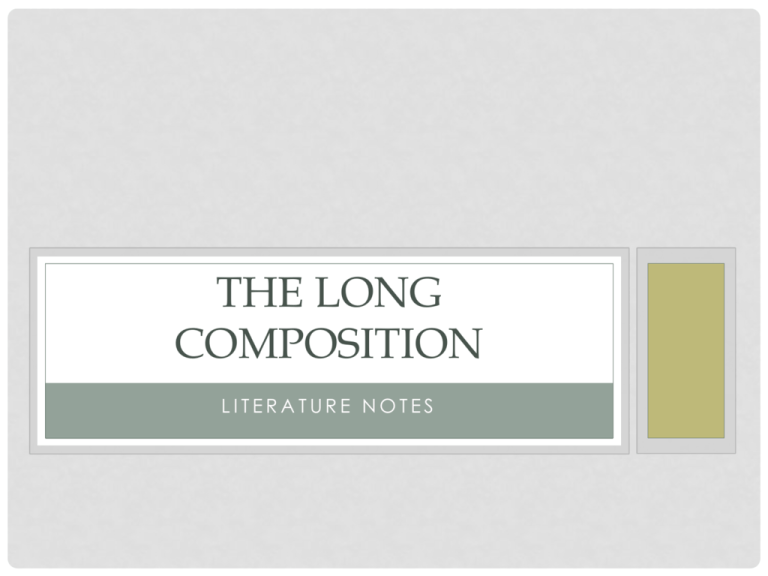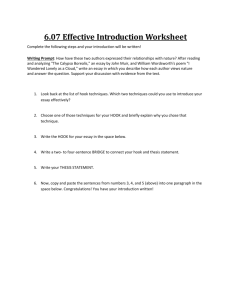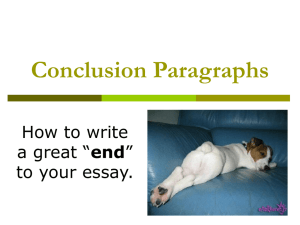The Long Composition - Ms. Filkins
advertisement

THE LONG COMPOSITION LITERATURE NOTES THE INTRODUCTION For the introduction in an essay, there are three parts: the hook, the bridge, and the thesis. The opening statement usually functions as a "hook" or attention grabber to draw in the reader. You can choose from five different types of hooks: the question, the quotation, the anecdote, the generalization, and the definition. After the hook comes your bridge statement, which explains how the hook is relevant to the thesis. The last sentence of the introductory paragraph contains the thesis statement, a sentence or two that is the central idea of your essay. THE INTRODUCTION: HOOKING YOUR READER • Question Hook: You ask your reader a question. Ex: “Have you ever been accused of doing something you didn’t do?” • Quotation Hook: You can use a quote by a famous author, singer, actor, philosopher, etc. Ex: Helen Keller once said, “Although the world is full of suffering, it is full also of overcoming it.” • Anecdote Hook: An anecdote is usually a short narrative of an interesting, amusing, or biographical incident. Ex: “When I was a freshman in high school, I was sent to the office for insubordination, however, I was not a bad kid; my teacher just wasn’t very fond of me.” • Generalization Hook: You make a generalization about society that relates to your topic. Ex: “Works of literature often feature characters that are accused of a crime they didn’t commit.” • Definition Hook: You define something that needs to be defined in your essay. Ex: Reasonable doubt is defined as a real doubt based upon reason and common sense after careful & impartial consideration of all evidence or lack of evidence in a case. THE INTRODUCTION: THE BRIDGE The most important bridge statement in an essay is found within the introductory paragraph, and it sets the scene for the reader. What your bridge says is dependent upon your hook. • If you choose the question, you may want to generally answer the question. • If you choose the quotation, explain the quotation in terms of your essay’s central idea. • If you choose the anecdote, discuss how the anecdote ties into your essay’s central idea. • If you choose the generalization, loosely discuss the themes found in your essay’s central idea. • If you choose the definition, loosely discuss the definition in terms of the themes found in your essay’s central idea. THE BODY PARAGRAPHS Body paragraphs have six parts: background, topic sentence, lead in, example, explication of the example, and a wrap up. For a long composition, you should write three body paragraphs. Each body paragraph should focus on three subtopics that prove your thesis is, in fact, valid. For a long composition, you should have nothing less than three body paragraphs. THE BODY PARAGRAPH: FORMAT BREAKDOWN • Background information: This is where you should give background about the story, any basic facts your reader needs to know, and define any more key terms. • Topic sentence: Your topic sentence is the subtopic you will address that proves your essay’s thesis is valid. • Lead in: A lead in usually takes the form of a transition into your example. • Example: In a long composition, you do not use direct quotes. Instead of direct quotes, you are supposed to summarize a quote, in your own words, from the text in order to back up your subtopic and overall thesis. • Explication of your example: You must analyze your example by explaining how your example proves your thesis is valid. • Wrap up: You must use strategic repetition and relate your findings in the body paragraph back to the thesis of your long composition. THE CONCLUSION Your conclusion is the place where you bring your essay to an end without leaving any loose ends. Your last paragraph should be at least six sentences. THE CONCLUSION: FORMAT BREAKDOWN • Transition & Restated Thesis: Use a sophisticated transition (stay away from “in conclusion”) and simply restate your thesis from your introduction • Summary of Main Points: Summarize each body paragraph in a sentence each. • Transition & Theme Statement: Use a sophisticated transition before you conclude your long composition with a strong statement that gets your reader thinking about life or human nature without moralizing or trivializing anything.




